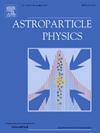The EUSO-SPB2 fluorescence telescope for the detection of Ultra-High Energy Cosmic Rays
IF 2.9
3区 物理与天体物理
Q1 ASTRONOMY & ASTROPHYSICS
引用次数: 0
Abstract
The Extreme Universe Space Observatory on a Super Pressure Balloon 2 (EUSO-SPB2) flew on May 13th and 14th of 2023. Consisting of two novel optical telescopes, the payload utilized next-generation instrumentation for the observations of extensive air showers from near space. One instrument, the fluorescence telescope (FT) searched for Ultra-High Energy Cosmic Rays (UHECRs) by recording the atmosphere below the balloon in the near-UV with a time resolution using 108 multi-anode photomultiplier tubes with a total of 6912 channels. Validated by pre-flight measurements during a field campaign, the energy threshold was estimated around 2 EeV with an expected event rate of approximately 1 event per 10 h of observation. Based on the limited time afloat, the expected number of UHECR observations throughout the flight is between 0 and 2. Consistent with this expectation, no UHECR candidate events have been found. The majority of events appear to be detector artifacts that were not rejected properly due to a shortened commissioning phase. Despite the earlier-than-expected termination of the flight, data were recorded which provide insights into the detectors stability in the near-space environment as well as the diffuse ultraviolet emissivity of the atmosphere, both of which are impactful to future experiments.
用于探测超高能量宇宙射线的 EUSO-SPB2 荧光望远镜
2023 年 5 月 13 日和 14 日,超压气球 2 上的极端宇宙空间观测站(EUSO-SPB2)进行了飞行。该有效载荷由两台新型光学望远镜组成,利用新一代仪器从近太空观测大范围的气流。其中的荧光望远镜(FT)利用 108 个多阳极光电倍增管(共 6912 个通道),以 1μs 的时间分辨率记录气球下方大气中的近紫外线,从而搜索超高能宇宙射线(UHECR)。通过实地活动期间的飞行前测量验证,能量阈值估计在 2 EeV 左右,预期事件发生率约为每 10 小时观测 1 次。由于飞行时间有限,预计整个飞行过程中 UHECR 的观测次数在 0 到 2 次之间。与这一预期一致,没有发现 UHECR 候选事件。大多数事件似乎是由于调试阶段缩短而没有被正确剔除的探测器伪影。尽管这次飞行比预期提前结束,但记录的数据使人们对探测器在近空间环境中的稳定性以及大气层的漫射紫外线发射率有了深入的了解,这两方面对未来的实验都有影响。
本文章由计算机程序翻译,如有差异,请以英文原文为准。
求助全文
约1分钟内获得全文
求助全文
来源期刊

Astroparticle Physics
地学天文-天文与天体物理
CiteScore
8.00
自引率
2.90%
发文量
41
审稿时长
79 days
期刊介绍:
Astroparticle Physics publishes experimental and theoretical research papers in the interacting fields of Cosmic Ray Physics, Astronomy and Astrophysics, Cosmology and Particle Physics focusing on new developments in the following areas: High-energy cosmic-ray physics and astrophysics; Particle cosmology; Particle astrophysics; Related astrophysics: supernova, AGN, cosmic abundances, dark matter etc.; Gravitational waves; High-energy, VHE and UHE gamma-ray astronomy; High- and low-energy neutrino astronomy; Instrumentation and detector developments related to the above-mentioned fields.
 求助内容:
求助内容: 应助结果提醒方式:
应助结果提醒方式:


